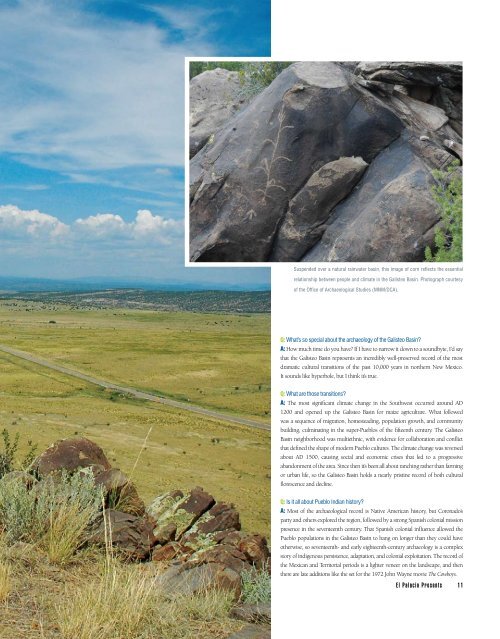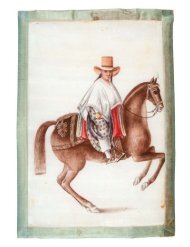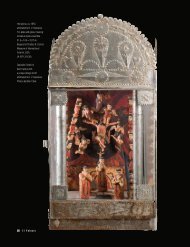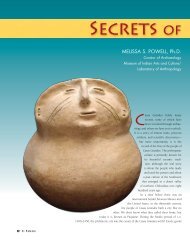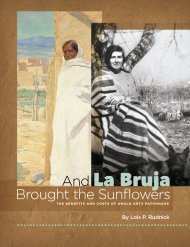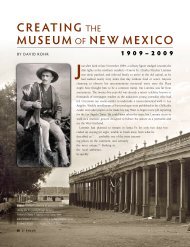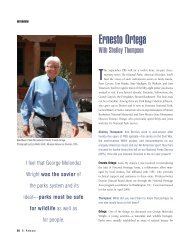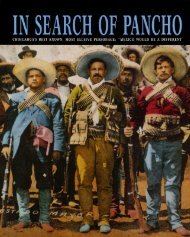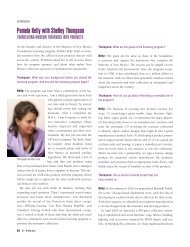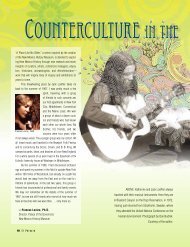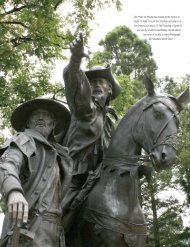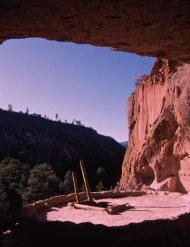Suspended over a natural rainwater basin, this image of corn reflects the essentialrelationship between people and climate in the <strong>Galisteo</strong> <strong>Basin</strong>. Photograph courtesyof the Office of Archaeological Studies (MNM/DCA).Q: What’s so special about the archaeology of the <strong>Galisteo</strong> <strong>Basin</strong>?A: How much time do you have? If I have to narrow it down to a soundbyte, I’d saythat the <strong>Galisteo</strong> <strong>Basin</strong> represents an incredibly well-preserved record of the mostdramatic cultural transitions of the past 10,000 years in northern New Mexico.It sounds like hyperbole, but I think it’s true.Q: What are those transitions?A: The most significant climate change in the Southwest occurred around AD1200 and opened up the <strong>Galisteo</strong> <strong>Basin</strong> for maize agriculture. What followedwas a sequence of migration, homesteading, population growth, and communitybuilding, culminating in the super-Pueblos of the fifteenth century. The <strong>Galisteo</strong><strong>Basin</strong> neighborhood was multiethnic, with evidence for collaboration and conflictthat defined the shape of modern Pueblo cultures. The climate change was reversedabout AD 1500, causing social and economic crises that led to a progressiveabandonment of the area. Since then it’s been all about ranching rather than farmingor urban life, so the <strong>Galisteo</strong> <strong>Basin</strong> holds a nearly pristine record of both culturalflorescence and decline.Q: Is it all about Pueblo Indian history?A: Most of the archaeological record is Native American history, but Coronado’sparty and others explored the region, followed by a strong Spanish colonial missionpresence in the seventeenth century. That Spanish colonial influence allowed thePueblo populations in the <strong>Galisteo</strong> <strong>Basin</strong> to hang on longer than they could haveotherwise, so seventeenth- and early eighteenth-century archaeology is a complexstory of indigenous persistence, adaptation, and colonial exploitation. The record ofthe Mexican and Territorial periods is a lighter veneer on the landscape, and thenthere are late additions like the set for the 1972 John Wayne movie The Cowboys.<strong>El</strong> <strong>Palacio</strong> Presents 11
The small sites are perhaps more atrisk than the big ones because theyappear to be less impressive andimportant.Q: Why is this any different from the archaeology in other areas of northern New Mexico?A: The <strong>Galisteo</strong> <strong>Basin</strong> is analogous to Bandelier National Monument in terms of being a mirrorfor human adaptation—in both places you can see the remains of a relatively pristine sequence ofhuman responses to climate change. What’s important is that the two records are contemporarybut different, and the differences are an important key to the diversity of modern Pueblopeoples. In Santa Fe and the Rio Grande Valley bottom, most of the archaeology is obscuredor obliterated by many subsequent layers of occupation, especially the population explosion ofthe nineteenth and twentieth centuries. Since the <strong>Galisteo</strong> <strong>Basin</strong> has been populated mainly bysheep, cattle, and horses since the Pueblo Revolt, the archaeological sites are much easier to seeand much less disturbed.Q: There seems to be a heightened interest in <strong>Galisteo</strong> <strong>Basin</strong> archaeology of late.A: That’s in part because our memories are relatively short. Archaeologists have been fascinatedby the <strong>Galisteo</strong> <strong>Basin</strong> since Adolph Bandelier was hosting scholars at the Fisher Brewery beergarden on Palace Avenue in the late-nineteenth century. Extensive excavations were carried outby Nels Nelson in the 1910s, but since then the basin has been viewed much like a preserve.Bertha Dutton carried out some important but only partially published excavations in the midtwentiethcentury, but archaeologists haven’t felt much urgency about the area until recently.Q: Why now?A: There are two reasons for the resurgence in interest. First, research done in the 1980s and1990s on the Pajarito Plateau and the Rio Grande Valley has posed some interesting questionsabout Puebloan cultural development. The <strong>Galisteo</strong> <strong>Basin</strong> is the next logical place to look foranswers. The second reason for interest is the perceived threat of development to the integrityof the basin as a whole.Q: Are Native Americans as interested in the <strong>Galisteo</strong> <strong>Basin</strong> as the archaeologists are?A: The simple answer is yes, but as I get older I find there are few simple answers toanything. As recently as a decade ago, Pueblo elders were arranging permission forpilgrimages to some of the sites, but those visits have stopped with the passing of thatgeneration. The Pueblo of Cochiti contributed funds for the purchase of Pueblo San Marcosby the Archaeological Conservancy, and some Pueblo families still have stories that relateto the <strong>Galisteo</strong> <strong>Basin</strong> in the time before the Spanish Reconquest. However, private landownership has had an intimidating effect on visitation, so many Pueblo people, includingreligious leaders, have never set foot in the basin.Q: Do you see interest increasing?A: I do. The current preservation efforts led by the Bureau of Land Management include aformal Native American advisory group. For many of the representatives the field trips havebeen the first chance to see the sites. Many times the sites, and especially the rock-art images, aretoo sensitive for discussion with us non-Natives, but a sense of reverence comes across clearly.When they are comfortable enough to tell us stories, it can be fascinating. <strong>El</strong>ders find that thesites can serve as a touchstone for telling stories and passing on religious information to youngermembers of the tribe. We hope that the formal consultations will lead to more visitation byreligious leaders.Q: Do archaeologists and Native Americans agree on the history represented by the sites?A: Most of the time the histories are parallel and compatible, but not always. Interestingcontrasts emerge where the archaeologists simply need to step aside. Comanche people havekept stories alive about the rock art at Comanche Gap without anyone having seen the rock artin generations. We helped a group of Comanche elders visit the site, and they quickly departedfrom the archaeological script that attributes the rock art to Pueblo people. In their stories,the images are vital Comanche symbols authored by Comanche artists at a formative time inComanche history.Wall remnants of the San Cristóbal church, constructed in the 1620s, still stand with the help of severalstabilization efforts. Above: Neg. No. 12070, Courtesy Palace of the Governors Photo Archives (NMHM/DCA). Below: Photographs courtesy of the Office of Archaeological Studies (MNM/DCA).Q: How do you resolve the conflicts?A: We don’t need resolution. There’s really no need for only one interpretation, and I can’tclaim that my archaeological story of today is truth since it may change when the next newpiece of information comes along. A panel of <strong>Galisteo</strong> rock-art images will hold a full suite of12 <strong>El</strong> <strong>Palacio</strong> Presents


